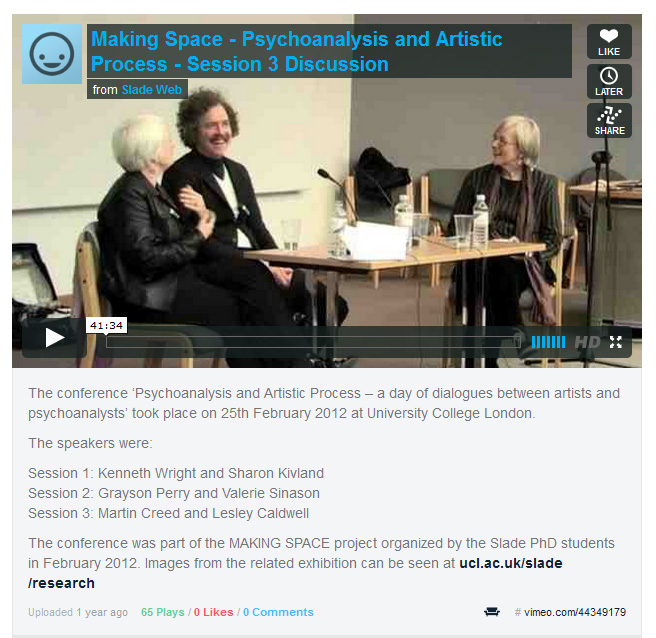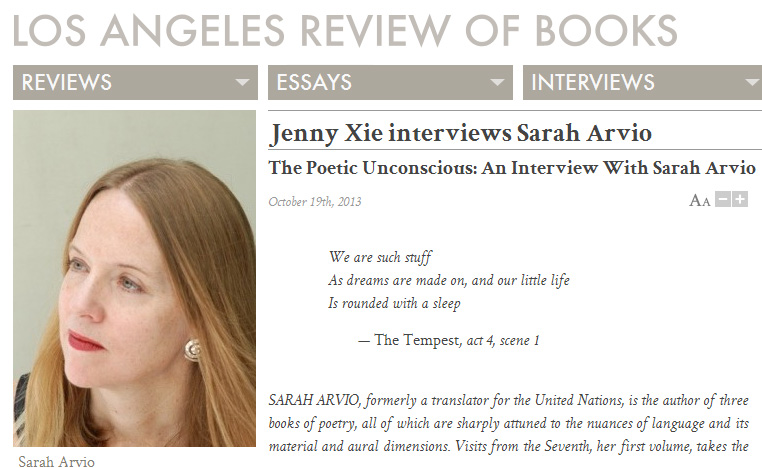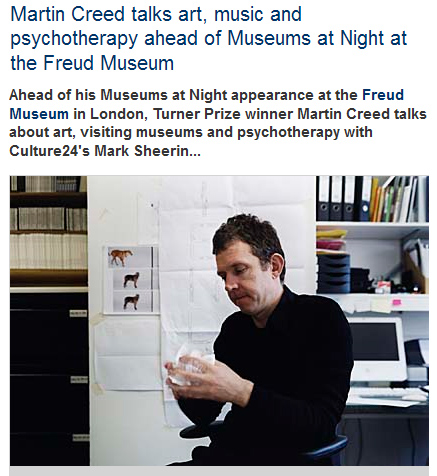 Videos from ‘Psychoanalysis and Artistic Process – a day of dialogues between artists and psychoanalysts’ which took place on 25th February 2012 at University College London. Discussion between artists and psychoanalysts including Kenneth Wright, Sharon Kivland, Grayson Perry, Valerie Sinason, Martin Creed and Lesley Caldwell.
Videos from ‘Psychoanalysis and Artistic Process – a day of dialogues between artists and psychoanalysts’ which took place on 25th February 2012 at University College London. Discussion between artists and psychoanalysts including Kenneth Wright, Sharon Kivland, Grayson Perry, Valerie Sinason, Martin Creed and Lesley Caldwell.
[To view these videos on Vimeo, please click here (page 1) and here (page2)]
Tag Archives: art & culture
On Poetry and psychoanalysis – Jenny Xie interviews Sarah Arvio
 [Click here to read the whole article on the website of the Los Angeles Review of Books]
[Click here to read the whole article on the website of the Los Angeles Review of Books]
“Poetry and psychoanalysis share a way of thinking: searching, reaching, shifting. They’re both an enactment of the mind, or a dance of the mind. Above all, they share the accidental discovery: the clarifying moment of surprise.”
The enduring legacy of Freud – Anna Freud
 [Read the whole article on the BBC website]
[Read the whole article on the BBC website]
The legacy of Sigmund Freud – the founder of psychoanalysis is well known. But perhaps less so is the impact his daughter Anna had, and continues to have, on child psychoanalysis. Anna, the youngest of Freud’s six children, was the only one to follow in her father’s footsteps. Her involvement began at the age of just 13, when she took part in her father’s weekly discussions on psychoanalytic ideas. Controversially, she is also believed to have received some informal therapy from her father. By the time of her death in 1982, Anna Freud’s work had revolutionised how we treat children in many walks of life, such as in hospital – with longer visiting hours when children are having treatment – and in the judicial system, where screens and video cameras are used when children have to give evidence. […]
Artist Martin Creed on his own psychoanalysis.
[Click here to read the whole article on Culture24.org.uk]
Anyone with more than a passing acquaintance with the practice of artist Martin Creed will know all about the fastidious numbering of his works. These begin with Work No.3 in 1986 (a yellow painting) and so far stretch as far as this year’s Work No. 1461 (an installation made with adhesive tape).
What might surprise you is that Creed’s appetite for order and record keeping extends to collecting sound files of every interview he undertakes. So when I catch him on the phone a technical hitch at his end throws the methodical artist.
“Wait, are you recording this?” he wants to know. “Can I get a copy of it?” And after the giving and receiving of assurances that I will later send him an MP3, we are ready to continue. It is quite clear that Creed takes the business of talking seriously.
This bodes well for those lucky enough to find themselves at the Freud Museum during Museums at Night 2013. On Thursday May 16 the Scottish artist will be on the spot, if not on the couch, as he improvises an after hours lecture, with the help of slide projections and a bit of music.
“It’s hard to do things,” he says. “Everything seems just as difficult as everything else: it’s just as much work to try to talk and say something that I think is alright as it is to try to fix and be okay with the shapes or colours in a painting or a sculpture or whatever.”
Creed refuses to be drawn about finer details pertaining to the evening: “I’m not sure — I’ll probably try just to think out loud and talk about whatever comes up”.
But he does admit the event should resonate with his newfound surroundings. “Absolutely, aye,” he says, “I do psychoanalysis and I’m a fan of Freud. Yeah, I have been [in analysis] for a very long time.”
Creed reveals he first saw an analyst in 1993: “I did it because I was desperate. I wanted to speak to someone.” Now he goes four times a week. “It’s a bit like going swimming or something like that: I think it’s an integral part of my life.”
At any rate, intensive therapy is clearly commensurate with a blue chip art career. This most exacting of artists views the activity as labour: “It’s work and I feel like I have to keep doing it.” This may come as some surprise, considering how effortless the artist’s official numbered works appear to be…
